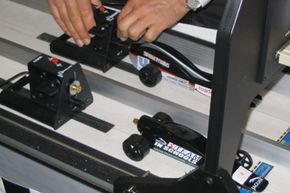CO2 Dragster Design
Like Pinewood Derby cars, the basic components for CO2 dragsters come in affordable kits that can be purchased at hobby shops or online. They typically include a wedge-shaped block of wood, a set of plastic wheels, axles to attach the wheels and a small CO2 cartridge. They retail for around $9 or $10 at many places [source: eNasco.com].
The car that arrives in the kit is essentially a blank slate. The wood can be crafted into just about any shape you choose using different tools, like small saws and drills. Often, the work is done in a wood shop or a manufacturing classroom. Most kits come with the holes for axles pre-drilled, but on some kits you may have to make your own using a drill press.
Advertisement
The dragster can be designed with a practical, aerodynamic shape, modeled after an actual racecar or given a crazy, eye-catching appearance. Paint, decals and add-ons are common ways to decorate them.
Many students have modeled their dragsters after Formula 1 cars, NASCAR racers or even the Batmobile. The best way to design a car is to draw up plans first, build a prototype (if you can) and then move on to the final version.
Remember, the CO2 car you're designing is a dragster -- meaning, a streamlined car that competes in drag racing, a sport where two or more vehicles compete to see who can move in a straight line the fastest. Handling is not an issue here.
Do you think you have a good design in mind for your car? The next thing to do will be to evaluate it to see how forces like drag and friction will affect it. We'll discuss the science behind dragsters on the next page.
